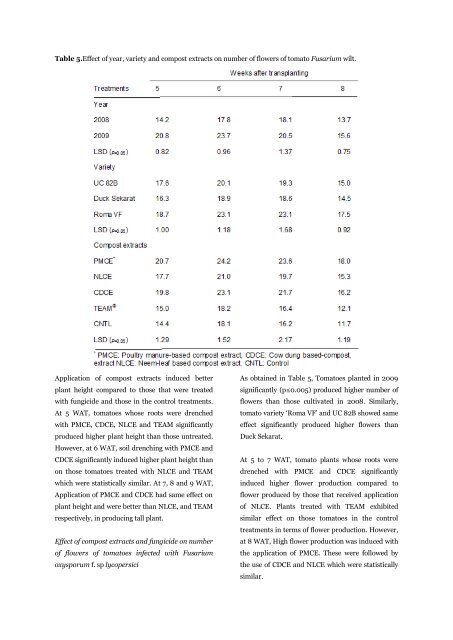Field evaluation of compost extracts for suppression of Fusarium wilt of tomato caused by Fusarium oxysporum F. sp. lycopersici
Abstract Field experiment was conducted at Research and Training Farm of Federal College of Horticulture Dadin Kowa, in the 2008 to 2009 cropping seasons, to evaluate the effect of compost extracts in suppressing Fusarium wilt on three tomato varieties. The treatments consisted of three compost extracts: poultry manure-based compost extract (PMCE), neem leaf-based compost extract (NLCE), cow dung-based compost extract (CDCE), a synthetic fungicide (TEAM®) and sterile distilled water serving as the control; and three tomato varieties (Roma VF, Duck Sekarat and UC 82B). The results showed that all tomato varieties were infected by the pathogen, but Roma VF was the least infected. Disease incidence and severity was significantly (P≤0.05) lower on tomato plants treated with the respective compost extract than on untreated plants. TEAM® was only effective at the early stages of infection compared to the various extracts which were effective starting from 6 – 7 weeks after transplanting till harvesting. However, poultry and cow dung based- compost extracts were the most effective in reducing incidence and severity of the disease. Higher yields were obtained with the application of PMCE (3.2 t ha-1) and CDCE (3.0 t ha-1) in comparism with other treatments. It is therefore recommended that farmers should use Roma VF and soil drenching with PMCE and/or CDCE in an integrated pest management package in the control of Fusarium wilt of tomato.
Abstract
Field experiment was conducted at Research and Training Farm of Federal College of Horticulture Dadin Kowa, in the 2008 to 2009 cropping seasons, to evaluate the effect of compost extracts in suppressing Fusarium wilt on three tomato varieties. The treatments consisted of three compost extracts: poultry manure-based compost extract (PMCE), neem leaf-based compost extract (NLCE), cow dung-based compost extract (CDCE), a synthetic fungicide (TEAM®) and sterile distilled water serving as the control; and three tomato varieties (Roma VF, Duck Sekarat and UC 82B). The results showed that all tomato varieties were infected by the pathogen, but Roma VF was the least infected. Disease incidence and severity was significantly (P≤0.05) lower on tomato plants treated with the respective compost extract than on untreated plants. TEAM® was only effective at the early stages of infection compared to the various extracts which were effective starting from 6 – 7 weeks after transplanting till harvesting. However, poultry and cow dung based- compost extracts were the most effective in reducing incidence and severity of the disease. Higher yields were obtained with the application of PMCE (3.2 t ha-1) and CDCE (3.0 t ha-1) in comparism with other treatments. It is therefore recommended that farmers should use Roma VF and soil drenching with PMCE and/or CDCE in an integrated pest management package in the control of Fusarium wilt of tomato.
Create successful ePaper yourself
Turn your PDF publications into a flip-book with our unique Google optimized e-Paper software.
Table 5.Effect <strong>of</strong> year, variety and <strong>compost</strong> <strong>extracts</strong> on number <strong>of</strong> flowers <strong>of</strong> <strong>tomato</strong> <strong>Fusarium</strong> <strong>wilt</strong>.<br />
Application <strong>of</strong> <strong>compost</strong> <strong>extracts</strong> induced better<br />
plant height compared to those that were treated<br />
with fungicide and those in the control treatments.<br />
At 5 WAT, <strong>tomato</strong>es whose roots were drenched<br />
with PMCE, CDCE, NLCE and TEAM significantly<br />
produced higher plant height than those untreated.<br />
However, at 6 WAT, soil drenching with PMCE and<br />
CDCE significantly induced higher plant height than<br />
on those <strong>tomato</strong>es treated with NLCE and TEAM<br />
which were statistically similar. At 7, 8 and 9 WAT,<br />
Application <strong>of</strong> PMCE and CDCE had same effect on<br />
plant height and were better than NLCE, and TEAM<br />
re<strong>sp</strong>ectively, in producing tall plant.<br />
Effect <strong>of</strong> <strong>compost</strong> <strong>extracts</strong> and fungicide on number<br />
<strong>of</strong> flowers <strong>of</strong> <strong>tomato</strong>es infected with <strong>Fusarium</strong><br />
<strong>oxy<strong>sp</strong>orum</strong> f. <strong>sp</strong> <strong>lycopersici</strong><br />
As obtained in Table 5, Tomatoes planted in 2009<br />
significantly (p≤0.005) produced higher number <strong>of</strong><br />
flowers than those cultivated in 2008. Similarly,<br />
<strong>tomato</strong> variety ‘Roma VF’ and UC 82B showed same<br />
effect significantly produced higher flowers than<br />
Duck Sekarat.<br />
At 5 to 7 WAT, <strong>tomato</strong> plants whose roots were<br />
drenched with PMCE and CDCE significantly<br />
induced higher flower production compared to<br />
flower produced <strong>by</strong> those that received application<br />
<strong>of</strong> NLCE. Plants treated with TEAM exhibited<br />
similar effect on those <strong>tomato</strong>es in the control<br />
treatments in terms <strong>of</strong> flower production. However,<br />
at 8 WAT, High flower production was induced with<br />
the application <strong>of</strong> PMCE. These were followed <strong>by</strong><br />
the use <strong>of</strong> CDCE and NLCE which were statistically<br />
similar.





![Review on: impact of seed rates and method of sowing on yield and yield related traits of Teff [Eragrostis teff (Zucc.) Trotter] | IJAAR @yumpu](https://documents.yumpu.com/000/066/025/853/c0a2f1eefa2ed71422e741fbc2b37a5fd6200cb1/6b7767675149533469736965546e4c6a4e57325054773d3d/4f6e6531383245617a537a49397878747846574858513d3d.jpg?AWSAccessKeyId=AKIAICNEWSPSEKTJ5M3Q&Expires=1714906800&Signature=Uy3YfxbnXj2M%2F8s9vj18wx%2Bj%2FlE%3D)












